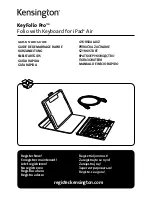
12
When resharpening the Gourmet edge use Stage 3 each time (alternating left and right
slots). If after a number of resharpenings, it is taking too long to resharpen, you can speed
the process by resharpening first in Stage 2 following the procedures detailed, and then
resharpen in Stage 3. By this method you will retain very smooth edges and prolong
the life of your knives. This procedure unlike conventional sharpeners will give you
extra-ordinary sharp knives every day while removing very little metal.
FOR MEATS, FIELD DRESSING AND HIGHLY FIBROUS MATERIALS
For butchering, field dressing or cutting fibrous materials you may find it advantageous to
sharpen in Stage 1 – followed directly by Stage 3. This will leave sharpened microflutes
along the facets near each side of the edge (Figure 11b) that will assist in the cutting of
such materials.
To prepare this type edge on either your Euro/American knives or contemporary Asian
knives, sharpen in Stage 1 (see page 6) until a burr is developed along the edge. Then
move directly to Stage 3 and make two or three pairs of pulls there.
To preserve this type of edge, when the knife needs resharpening, use Stage 3 for only one
or two resharpenings. Then go back to Stage 1 for one pull in each of the left and right slots
and then return directly to Stage 3. Do not oversharpen in Stage 1.
FOR GAME AND FISH
The optimum edge for cooked poultry generally can be obtained by using Stage 2 followed
by Stage 3. (Figure11c). For raw poultry, Stage 1 followed by Stage 3 as described above
may be preferable.
For filleting fish use a thin but sturdy blade sharpened in Stages 2 and 3.
PROCEDURE FOR SHARPENING SERRATED BLADES
Serrated blades are similar to saw blades with scalloped depressions and a series of
pointed teeth. In normal use the pointed teeth do most of the cutting.
Figure 12. Use only Stage 3 for sharpening
serrated knives.
Figure 13. Use dressing tools sparingly (see following
page for instructions).


































